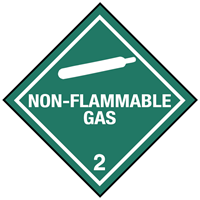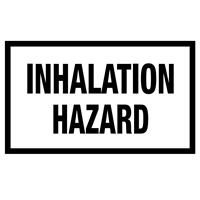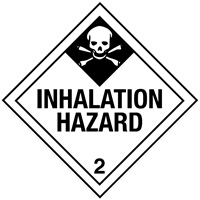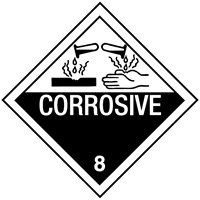Chemical Datasheet
AMMONIA, ANHYDROUS |




|
Chemical Identifiers
The
Chemical Identifier fields
include common identification numbers, the
NFPA diamond
U.S. Department of Transportation hazard labels, and a general
description of the chemical. The information in CAMEO Chemicals comes
from a variety of
data sources.
| CAS Number | UN/NA Number | DOT Hazard Label | USCG CHRIS Code |
|---|---|---|---|
|
|
||
| NIOSH Pocket Guide | International Chem Safety Card | ||
Ammonia
|
|||
NFPA 704
| Diamond | Hazard | Value | Description | |||||||||
|---|---|---|---|---|---|---|---|---|---|---|---|---|
|
|
3 | Can cause serious or permanent injury. | |||||||||
|
|
1 | Must be preheated before ignition can occur. | ||||||||||
|
|
0 | Normally stable, even under fire conditions. | ||||||||||
|
|
Note: The Refrigeration System Classification section of the International Mechanical Code requires a value of 3 for the red quadrant (flammability hazard) for indoor ammonia refrigeration equipment.
(NFPA, 2010)
General Description
A clear colorless gas with a strong odor. Shipped as a liquid under its own vapor pressure. Density (liquid) 6 lb / gal. Contact with the unconfined liquid can cause frostbite. Gas generally regarded as nonflammable but does burn within certain vapor concentration limits and with strong ignition. Fire hazard increases in the presence of oil or other combustible materials. Although gas is lighter than air, vapors from a leak initially hug the ground. Prolonged exposure of containers to fire or heat may cause violent rupturing and rocketing. Long-term inhalation of low concentrations of the vapors or short-term inhalation of high concentrations has adverse health effects. Used as a fertilizer, as a refrigerant, and in the manufacture of other chemicals.
Rate of onset: Immediate
Persistence: Minutes
Odor threshold: 17 ppm
Source/use/other hazard: Explosives manufacture; pesticides; detergents industry.
Rate of onset: Immediate
Persistence: Minutes
Odor threshold: 17 ppm
Source/use/other hazard: Explosives manufacture; pesticides; detergents industry.
Hazards
The
Hazard fields
include
special hazard alerts
air and water
reactions, fire hazards, health hazards, a reactivity profile, and
details about
reactive groups assignments
and
potentially incompatible absorbents.
The information in CAMEO Chemicals comes from a variety of
data sources.
Reactivity Alerts
- Water-Reactive
Air & Water Reactions
Soluble in water with evolution of heat. The amount of heat generated may be large.
Fire Hazard
Mixing of ammonia with several chemicals can cause severe fire hazards and/or explosions. Ammonia in container may explode in heat of fire. Incompatible with many materials including silver and gold salts, halogens, alkali metals, nitrogen trichloride, potassium chlorate, chromyl chloride, oxygen halides, acid vapors, azides, ethylene oxide, picric acid and many other chemicals. Mixing with other chemicals and water. Hazardous polymerization may not occur. (EPA, 1998)
Health Hazard
Vapors cause irritation of eyes and respiratory tract. Liquid will burn skin and eyes. Poisonous; may be fatal if inhaled. Contact may cause burns to skin and eyes. Contact with liquid may cause frostbite. (EPA, 1998)
Reactivity Profile
AMMONIA is a base. Reacts exothermically with all acids. Violent reactions are possible. Readily combines with silver oxide or mercury to form compounds that explode on contact with halogens. When in contact with chlorates it forms explosive ammonium chlorate [Kirk-Othmer, 3rd ed., Vol. 2, 1978, p. 470]. Reacts violently or produces explosive products with fluorine, chlorine, bromine and iodine and some of the interhalogen compounds (bromine pentafluoride, chlorine trifluoride). Mixing of bleaching powder (hypochlorite solution) with ammonia solutions produces toxic/explosive ammonia trichloride vapors. Undergoes potentially violent or explosive reactions on contact with 1,2-dichloroethane (with liquid ammonia), boron halides, ethylene oxide (polymerization), perchlorates or strong oxidants (chromyl chloride, chromium trioxide, chromic acid, nitric acid, hydrogen peroxide, chlorates, fluorine, nitrogen oxide, liquid oxygen). Reacts with silver chloride, silver oxide, silver nitrate or silver azide to form the explosive silver nitride. May react with some heavy metal compounds (mercury, gold(III) chloride) to produce materials that may explode when dry. [Bretherick, 5th ed., 1995, p. 1553].
Belongs to the Following Reactive Group(s)
Potentially Incompatible Absorbents
No information available.
Response Recommendations
The
Response Recommendation fields
include isolation and evacuation distances, as well as recommendations for
firefighting, non-fire response, protective clothing, and first aid. The
information in CAMEO Chemicals comes from a variety of
data sources.
Isolation and Evacuation
Excerpt from ERG Guide 125 [Gases - Toxic and/or Corrosive]:
IMMEDIATE PRECAUTIONARY MEASURE: Isolate spill or leak area for at least 100 meters (330 feet) in all directions.
SPILL: See ERG Tables 1 and 3 - Initial Isolation and Protective Action Distances on the UN/NA 1005 datasheet.
FIRE: If tank, rail tank car or highway tank is involved in a fire, ISOLATE for 1600 meters (1 mile) in all directions; also, consider initial evacuation for 1600 meters (1 mile) in all directions. (ERG, 2024)
IMMEDIATE PRECAUTIONARY MEASURE: Isolate spill or leak area for at least 100 meters (330 feet) in all directions.
SPILL: See ERG Tables 1 and 3 - Initial Isolation and Protective Action Distances on the UN/NA 1005 datasheet.
FIRE: If tank, rail tank car or highway tank is involved in a fire, ISOLATE for 1600 meters (1 mile) in all directions; also, consider initial evacuation for 1600 meters (1 mile) in all directions. (ERG, 2024)
Firefighting
Wear positive pressure breathing apparatus and full protective clothing.
Small fires: dry chemical or carbon dioxide. Large fires: water spray, fog or foam. Apply water gently to the surface. Do not get water inside container. Move container from fire area if you can do it without risk. Stay away from ends of tanks. Cool containers that are exposed to flames with water from the side until well after fire is out. Isolate area until gas has dispersed. (EPA, 1998)
Small fires: dry chemical or carbon dioxide. Large fires: water spray, fog or foam. Apply water gently to the surface. Do not get water inside container. Move container from fire area if you can do it without risk. Stay away from ends of tanks. Cool containers that are exposed to flames with water from the side until well after fire is out. Isolate area until gas has dispersed. (EPA, 1998)
Non-Fire Response
Excerpt from ERG Guide 125 [Gases - Toxic and/or Corrosive]:
Do not touch or walk through spilled material. Stop leak if you can do it without risk. If possible, turn leaking containers so that gas escapes rather than liquid. Prevent entry into waterways, sewers, basements or confined areas. Do not direct water at spill or source of leak. Use water spray to reduce vapors or divert vapor cloud drift. Avoid allowing water runoff to contact spilled material. Isolate area until gas has dispersed. (ERG, 2024)
Do not touch or walk through spilled material. Stop leak if you can do it without risk. If possible, turn leaking containers so that gas escapes rather than liquid. Prevent entry into waterways, sewers, basements or confined areas. Do not direct water at spill or source of leak. Use water spray to reduce vapors or divert vapor cloud drift. Avoid allowing water runoff to contact spilled material. Isolate area until gas has dispersed. (ERG, 2024)
Protective Clothing
For emergency situations, wear a positive pressure, pressure-demand, full facepiece self-contained breathing apparatus (SCBA) or pressure- demand supplied air respirator with escape SCBA and a fully-encapsulating, chemical resistant suit. (EPA, 1998)
DuPont Tychem® Suit Fabrics
Tychem® Fabric Legend
| QS = Tychem 2000 SFR |
| QC = Tychem 2000 |
| SL = Tychem 4000 |
| C3 = Tychem 5000 |
| TF = Tychem 6000 |
| TP = Tychem 6000 FR |
| RC = Tychem RESPONDER® CSM |
| TK = Tychem 10000 |
| RF = Tychem 10000 FR |
Testing Details
The fabric permeation data was generated for DuPont by a third party
laboratory. Permeation data for industrial chemicals is obtained per
ASTM F739. Normalized breakthrough times (the time at which the
permeation rate exceeds 0.1 μg/cm2/min) are reported in minutes. All
chemicals have been tested between approximately 20°C and 27°C unless
otherwise stated. All chemicals have been tested at a concentration of
greater than 95% unless otherwise stated.
Chemical warfare agents (Lewisite, Sarin, Soman, Sulfur Mustard, Tabun
and VX Nerve Agent) have been tested at 22°C and 50% relative humidity
per military standard MIL-STD-282. "Breakthrough time" for chemical
warfare agents is defined as the time when the cumulative mass which
permeated through the fabric exceeds the limit in MIL-STD-282 [either
1.25 or 4.0 μg/cm2].
A Caution from DuPont
This information is based upon technical data that DuPont believes to
be reliable on the date issued. It is subject to revision as additional
knowledge and experience are gained. The information reflects
laboratory performance of fabrics, not complete garments, under
controlled conditions. It is intended for informational use by persons
having technical skill for evaluation under their specific end-use
conditions, at their own discretion and risk. It is the user's
responsibility to determine the level of toxicity and the proper
personal protective equipment needed. Anyone intending to use this
information should first verify that the garment selected is suitable
for the intended use. In many cases, seams and closures have shorter
breakthrough times and higher permeation rates than the fabric. If
fabric becomes torn,abraded or punctured, or if seams or closures fail,
or if attached gloves, visors, etc. are damaged, end user should
discontinue use of garment to avoid potential exposure to chemical.
Since conditions of use are outside our control, DuPont makes no
warranties, express or implied, including, without limitation, no
warranties of merchantability or fitness for a particular use and
assume no liability in connection with any use of this information.
This information is not intended as a license to operate under or a
recommendation to infringe any patent, trademark or technical
information of DuPont or others covering any material or its use.
| Chemical | CAS Number | State | QS | QC | SL | C3 | TF | TP | RC | TK | RF |
|---|---|---|---|---|---|---|---|---|---|---|---|
| Ammonia (-33°C, liquid) | 7664-41-7 | Liquid | 35 | 20 | 30 | >480 | |||||
| Ammonia (-70°C, liquid) | 7664-41-7 | Liquid | >480 | >480 | >480 | ||||||
| Ammonia (gaseous) | 7664-41-7 | Vapor | imm | imm | 26 | imm | 20 | 90 | 105*/133 | >480 | >480 |
> indicates greater than.
"imm" indicates immediate; having a normalized breakthrough time of 10 minutes or less.
* indicates based on lowest single value.
"imm" indicates immediate; having a normalized breakthrough time of 10 minutes or less.
* indicates based on lowest single value.
Special Warning from DuPont: Tychem® and Tyvek® fabrics should not be used around heat, flames, sparks or in potentially flammable or explosive environments. Only...
...Tychem® ThermoPro, Tychem® Reflector® and Tychem® TK styles 600T/601T
(with aluminized outer suit) garments are designed and tested to help
reduce burn injury during escape from a flash fire. Users of Tychem®
ThermoPro, Tychem® Reflector® and Tychem® TK styles 600T/601T (with
aluminized outer suit) garments should not knowingly enter an explosive
environment. Tychem® garments with attached socks must be worn inside
protective outer footwear and are not suitable as outer footwear. These
attached socks do not have adequate durability or slip resistance to be
worn as the outer foot covering.
(DuPont, 2024)
First Aid
Warning: Ammonia is extremely corrosive to the skin, eyes, and mucous membranes. Contact with the liquified gas may cause frostbite. Caution is advised.
Signs and Symptoms of Acute Ammonia Exposure: Inhalation of ammonia may cause irritation and burns of the respiratory tract, laryngitis, dyspnea (shortness of breath), stridor (high-pitched respirations), and chest pain. Pulmonary edema and pneumonia may also result from inhalation. A pink frothy sputum, convulsions, and coma are often seen following exposure to high concentrations. When ammonia is ingested, nausea and vomiting may result; oral, esophageal, and stomach burns are common. If ammonia has contacted the eyes, irritation, pain, conjunctivitis (red, inflamed eyes), lacrimation (tearing), and corneal erosion may occur. Loss of vision is possible. Dermal exposure may result in severe burns and pain.
Emergency Life-Support Procedures: Acute exposure to ammonia may require decontamination and life support for the victims. Emergency personnel should wear protective clothing appropriate to the type and degree of contamination. Air-purifying or supplied-air respiratory equipment should also be worn, as necessary.
Inhalation Exposure:
1. Move victims to fresh air. Emergency personnel should avoid self-exposure to ammonia.
2. Evaluate vital signs including pulse and respiratory rate, and note any trauma. If no pulse is detected, provide CPR. If not breathing, provide artificial respiration. If breathing is labored, administer oxygen or other respiratory support.
3. Obtain authorization and/or further instructions from the local hospital for administration of an antidote or performance of other invasive procedures.
4. Transport to a health care facility.
Dermal/Eye Exposure:
1. Remove victims from exposure. Emergency personnel should avoid self- exposure to ammonia.
2. Evaluate vital signs including pulse and respiratory rate, and note any trauma. If no pulse is detected, provide CPR. If not breathing, provide artificial respiration. If breathing is labored, administer oxygen or other respiratory support.Warning: Do not attempt to neutralize with an acid wash; excessive liberation of heat may result.
3. If eye exposure has occurred, eyes must IMMEDIATELY be flushed with lukewarm water for at least 15 minutes.
4. Remove contaminated clothing as soon as possible.
5. Wash exposed skin areas THOROUGHLY with soap and water.
6. Obtain authorization and/or further instructions from the local hospital for administration of an antidote or performance of other invasive procedures.
7. Transport to a health care facility.
Ingestion Exposure:
1. Evaluate vital signs including pulse and respiratory rate, and note any trauma. If no pulse is detected, provide CPR. If not breathing, provide artificial respiration. If breathing is labored, administer oxygen or other respiratory support.
2. DO NOT induce vomiting or attempt to neutralize!
3. Obtain authorization and/or further instructions from the local hospital for administration of an antidote or performance of other invasive procedures.
4. Activated charcoal does not strongly bind ammonia, and therefore is of little or no value.
5. Give the victims water or milk: children up to 1 year old, 125 mL (4 oz or 1/2 cup); children 1 to 12 years old, 200 mL (6 oz or 3/4 cup); adults, 250 mL (8 oz or 1 cup). Water or milk should be given only if victims are conscious and alert.
6. Transport to a health care facility. (EPA, 1998)
Signs and Symptoms of Acute Ammonia Exposure: Inhalation of ammonia may cause irritation and burns of the respiratory tract, laryngitis, dyspnea (shortness of breath), stridor (high-pitched respirations), and chest pain. Pulmonary edema and pneumonia may also result from inhalation. A pink frothy sputum, convulsions, and coma are often seen following exposure to high concentrations. When ammonia is ingested, nausea and vomiting may result; oral, esophageal, and stomach burns are common. If ammonia has contacted the eyes, irritation, pain, conjunctivitis (red, inflamed eyes), lacrimation (tearing), and corneal erosion may occur. Loss of vision is possible. Dermal exposure may result in severe burns and pain.
Emergency Life-Support Procedures: Acute exposure to ammonia may require decontamination and life support for the victims. Emergency personnel should wear protective clothing appropriate to the type and degree of contamination. Air-purifying or supplied-air respiratory equipment should also be worn, as necessary.
Inhalation Exposure:
1. Move victims to fresh air. Emergency personnel should avoid self-exposure to ammonia.
2. Evaluate vital signs including pulse and respiratory rate, and note any trauma. If no pulse is detected, provide CPR. If not breathing, provide artificial respiration. If breathing is labored, administer oxygen or other respiratory support.
3. Obtain authorization and/or further instructions from the local hospital for administration of an antidote or performance of other invasive procedures.
4. Transport to a health care facility.
Dermal/Eye Exposure:
1. Remove victims from exposure. Emergency personnel should avoid self- exposure to ammonia.
2. Evaluate vital signs including pulse and respiratory rate, and note any trauma. If no pulse is detected, provide CPR. If not breathing, provide artificial respiration. If breathing is labored, administer oxygen or other respiratory support.Warning: Do not attempt to neutralize with an acid wash; excessive liberation of heat may result.
3. If eye exposure has occurred, eyes must IMMEDIATELY be flushed with lukewarm water for at least 15 minutes.
4. Remove contaminated clothing as soon as possible.
5. Wash exposed skin areas THOROUGHLY with soap and water.
6. Obtain authorization and/or further instructions from the local hospital for administration of an antidote or performance of other invasive procedures.
7. Transport to a health care facility.
Ingestion Exposure:
1. Evaluate vital signs including pulse and respiratory rate, and note any trauma. If no pulse is detected, provide CPR. If not breathing, provide artificial respiration. If breathing is labored, administer oxygen or other respiratory support.
2. DO NOT induce vomiting or attempt to neutralize!
3. Obtain authorization and/or further instructions from the local hospital for administration of an antidote or performance of other invasive procedures.
4. Activated charcoal does not strongly bind ammonia, and therefore is of little or no value.
5. Give the victims water or milk: children up to 1 year old, 125 mL (4 oz or 1/2 cup); children 1 to 12 years old, 200 mL (6 oz or 3/4 cup); adults, 250 mL (8 oz or 1 cup). Water or milk should be given only if victims are conscious and alert.
6. Transport to a health care facility. (EPA, 1998)
Physical Properties
The
Physical Property fields
include properties such as vapor pressure and
boiling point, as well as explosive limits and
toxic exposure thresholds
The information in CAMEO Chemicals comes from a variety of
data sources.
Note: For Vapor Density and Specific Gravity, comparing the value to 1.0 can tell you if the chemical will likely sink/rise in air or sink/float in fresh water (respectively). Short phrases have been added to those values below as an aid. However, make sure to also consider the circumstances of a release. The Vapor Density comparisons are only valid when the gas escaping is at the same temperature as the surrounding air itself. If the chemical is escaping from a container where it was pressurized or refrigerated, it may first escape and behave as a heavy gas and sink in the air (even if it has a Vapor Density value less than 1). Also, the Specific Gravity comparisons are for fresh water (density 1.0 g/mL). If your spill is in salt water (density about 1.027 g/mL), you need to adjust the point of comparison. There are some chemicals that will sink in fresh water and float in salt water.
Note: For Vapor Density and Specific Gravity, comparing the value to 1.0 can tell you if the chemical will likely sink/rise in air or sink/float in fresh water (respectively). Short phrases have been added to those values below as an aid. However, make sure to also consider the circumstances of a release. The Vapor Density comparisons are only valid when the gas escaping is at the same temperature as the surrounding air itself. If the chemical is escaping from a container where it was pressurized or refrigerated, it may first escape and behave as a heavy gas and sink in the air (even if it has a Vapor Density value less than 1). Also, the Specific Gravity comparisons are for fresh water (density 1.0 g/mL). If your spill is in salt water (density about 1.027 g/mL), you need to adjust the point of comparison. There are some chemicals that will sink in fresh water and float in salt water.
| Chemical Formula: |
|
Flash Point: data unavailable
Lower Explosive Limit (LEL):
16 %
(EPA, 1998)
Upper Explosive Limit (UEL):
25 %
(EPA, 1998)
Autoignition Temperature:
1204°F
(USCG, 1999)
Melting Point:
-107.9°F
(EPA, 1998)
Vapor Pressure:
400 mmHg
at -49.72°F
(EPA, 1998)
Vapor Density (Relative to Air):
0.6
(EPA, 1998)
- Lighter than air; will rise
Specific Gravity:
0.6818
at -28.03°F
(EPA, 1998)
- Less dense than water; will float
Boiling Point:
-28.03°F
at 760 mmHg
(EPA, 1998)
Molecular Weight:
17.03
(EPA, 1998)
Water Solubility:
34 %
(NIOSH, 2024)
Ionization Energy/Potential:
10.18 eV
(NIOSH, 2024)
IDLH:
300 ppm
(NIOSH, 2024)
AEGLs (Acute Exposure Guideline Levels)
| Exposure Period | AEGL-1 | AEGL-2 | AEGL-3 |
|---|---|---|---|
| 10 minutes | 30 ppm | 220 ppm | 2700 ppm |
| 30 minutes | 30 ppm | 220 ppm | 1600 ppm |
| 60 minutes | 30 ppm | 160 ppm | 1100 ppm |
| 4 hours | 30 ppm | 110 ppm | 550 ppm |
| 8 hours | 30 ppm | 110 ppm | 390 ppm |
(NAC/NRC, 2024)
ERPGs (Emergency Response Planning Guidelines)
| Chemical | ERPG-1 | ERPG-2 | ERPG-3 |
|---|---|---|---|
| Ammonia (7664-41-7) | 25 ppm |
150 ppm | 1500 ppm |
(AIHA, 2022)
PACs (Protective Action Criteria)
| Chemical | PAC-1 | PAC-2 | PAC-3 | |
|---|---|---|---|---|
| Ammonia (7664-41-7) | 30 ppm | 160 ppm | 1100 ppm | LEL = 150000 ppm |
(DOE, 2024)
Regulatory Information
The
Regulatory Information fields
include information from
the U.S. Environmental Protection Agency's Title III Consolidated List of
Lists,
the U.S. Cybersecurity and Infrastructure Security Agency's Chemical Facility
Anti-Terrorism Standards,
and the U.S. Occupational Safety and Health Administration's
Process Safety Management of Highly Hazardous Chemicals Standard List
(see more about these
data sources).
EPA Consolidated List of Lists
| Regulatory Name | CAS Number/ 313 Category Code |
EPCRA 302 EHS TPQ |
EPCRA 304 EHS RQ |
CERCLA RQ | EPCRA 313 TRI |
RCRA Code |
CAA 112(r) RMP TQ |
|---|---|---|---|---|---|---|---|
| Ammonia | 7664-41-7 | 500 pounds | 100 pounds | 100 pounds | |||
| Ammonia (anhydrous) | 7664-41-7 | 500 pounds | 100 pounds | 100 pounds | X | 10000 pounds | |
| Ammonia (conc 20% or greater) | 7664-41-7 | See ammonium hydroxide | X | 20000 pounds | |||
| Ammonia (includes anhydrous ammonia and aqueous ammonia from water dissociable ammonium salts and other sources; 10 percent of total aqueous ammonia is reportable under this listing) | 7664-41-7 | 313 |
- "X" indicates that this is a second name for an EPCRA section 313 chemical already included on this consolidated list. May also indicate that the same chemical with the same CAS number appears on another list with a different chemical name.
(EPA List of Lists, 2024)
CISA Chemical Facility Anti-Terrorism Standards (CFATS)
| RELEASE | THEFT | SABOTAGE | ||||||||
|---|---|---|---|---|---|---|---|---|---|---|
| Chemical of Interest | CAS Number | Min Conc | STQ | Security Issue |
Min Conc | STQ | Security Issue |
Min Conc | STQ | Security Issue |
| Ammonia (anhydrous) | 7664-41-7 | 1.00 % | 10000 pounds | toxic | ||||||
| Ammonia (conc. 20% or greater) | 7664-41-7 | 20.00 % | 20000 pounds | toxic | ||||||
(CISA, 2007)
OSHA Process Safety Management (PSM) Standard List
| Chemical Name | CAS Number | Threshold Quantity (TQ) |
|---|---|---|
| Ammonia solutions (>44% ammonia by weight) | 7664-41-7 | 15000 pounds |
| Ammonia, Anhydrous | 7664-41-7 | 10000 pounds |
(OSHA, 2019)
Alternate Chemical Names
This section provides a listing of alternate names for this chemical,
including trade names and synonyms.
- AM-FOL
- AMMONIA
- AMMONIA (ANHYDROUS)
- AMMONIA (ANHYDROUS) (LIQUEFIED)
- AMMONIA GAS
- AMMONIA SOLUTION, WITH MORE THAN 50% AMMONIA
- AMMONIA, ANHYDROUS
- AMMONIA, ANHYDROUS, LIQUEFIED
- AMMONIA, [ANHYDROUS]
- AMMONIA-14N
- ANHYDROUS AMMONIA
- ANHYDROUS AMMONIA, LIQUEFIED
- AQUA AMMONIA
- AQUEOUS AMMONIA
- LIQUID AMMONIA
- NITRO-SIL
- R 717
- REFRIGERENT R717
- SPIRIT OF HARTSHORN



